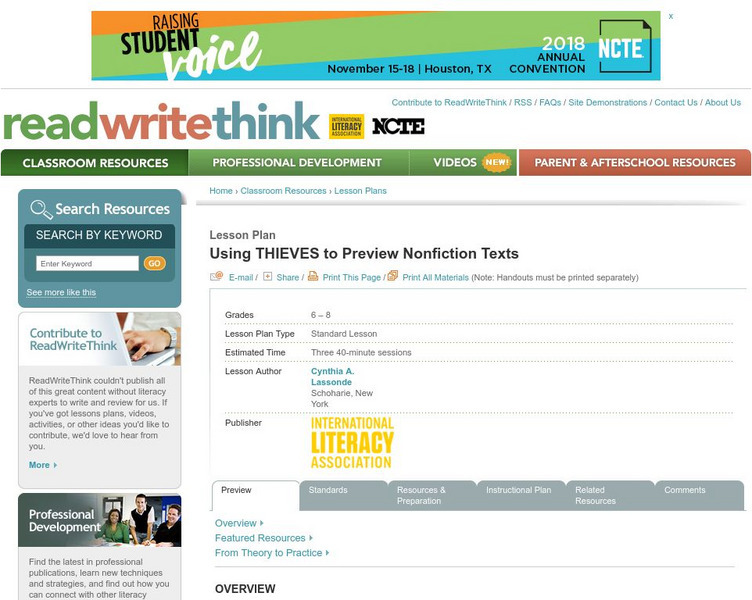Curated OER
Historical Figures
Student research a "Historical Individual" using the Internet. They print a minimum of five articles and organize them. They create a visual biography of their historical figure.
Curated OER
Cultural "I Amm" Speech Project
Eleventh graders use the internet and other sources to research a selected individual. They explore important events, challenges, and the impact and influence the person had on US History. Using the information gathered, 11th graders...
Curated OER
Comprehension Game for Guided Reading
Students play reading comprehension games. For this guided reading lesson plan, students play a comprehension game made by the teacher. Students may play the game before or after reading the story.
Curated OER
McLean Train Yard
Students conduct online research and incorporate graphics and maps into a Powerpoint presentation that details life at the McLean train yard in its heyday.
Curated OER
Honey ! I Blew Up The Bee!
Second graders complete a variety of bee-themed activities. They consider the importance of honeybees in food production, conduct Internet research, prepare foods using honey, complete puzzles and compile a portfolio of their work.
Curated OER
SNACK TIME
Students explore writing sequential information by composing the simple recipe of peanut buttera and jelly sandwiches.
ReadWriteThink
Read Write Think: Using Narrative for Expository Text
Lesson in which students read various narrative texts which provide a context for them to learn content-area topics. Narratives allow the students to begin to understand expository texts.
Florida Center for Reading Research
Florida Center for Reading Research: Expository Text Structure: Book Look [Pdf]
A lesson plan in which learners look through a book to identify text features and complete a graphic organizer. Materials are included.
Florida Center for Reading Research
Florida Center for Reading Research: Expository Text Structure: Research Roundup
A lesson plan in which learners complete graphic organizers as they gather research information. Materials are included.
Florida Center for Reading Research
Florida Center for Reading Research: Expository Text Structure: Just the Facts
A lesson plan in which students read a text and complete a graphic organizer to identify the topic and supporting details or facts. Materials are included.
Florida Center for Reading Research
Florida Center for Reading Research: Expository Text Structure: Summarizing [Pdf]
A lesson plan in which students read a text and record the main ideas and supporting details on a graphic organizer. Students then complete the organizer by writing a summary of the text. Materials are included.
Florida Center for Reading Research
Florida Center for Reading Research: Expository Text Structure: Main Idea Mania
A lesson plan in which students read a text and record the main ideas and supporting details on one of the graphic organizers provided. Materials are included. [PDF]
ReadWriteThink
Read Write Think: Exploring How Section Headings Support Understanding
Teaching learners to pay attention to headings and titles as they read? Here you'll find a practical application for using an expository text to apply the concept of using headings. Geared toward older elementary students, but lesson...
Florida Center for Reading Research
Florida Center for Reading Research: Expository Text Structure: Super Summary [Pdf]
A lesson plan in which students read a text and then complete a graphic organizer to help them write a summary. Materials are included.
Florida Center for Reading Research
Florida Center for Reading Research: Exp. Text Structure: Projected Paragraphs
A lesson plan in which students read a text and highlight the most important details. Materials are included. [PDF]
Florida Center for Reading Research
Florida Center for Reading Research: Keys to the Main Idea [Pdf]
A lesson plan in which students read a text a complete a graphic organizer to identify the main ideas and supporting details. Materials are included.
Florida Center for Reading Research
Florida Center for Reading Research: Exp. Text Structure: Text Structure Sort [Pdf]
A lesson plan in which students read short texts and sort them according to structure: cause and effect, problem and solution, question and answer, compare and contrast, description, and sequence. Materials are included.
Florida Center for Reading Research
Florida Center for Reading Research: Exp. Text Structure: Text Feature Find
A lesson plan in which students look through a book to find various text features including: a table of contents, sequence and format, charts/graphs/maps, diagrams/graphics/illustrations, print variations, an index, and a glossary....
ReadWriteThink
Read Write Think: Playing With Genre Through Newspapers and Short Stories
Contains plans for three lessons that ask students to compare narrative writing (short stories) to expository writing (news articles) in order to understand what makes each genre unique. In addition to objectives and standards, this...
CPALMS
Cpalms: Compare/contrast Life Cycle Texts
[Free Registration/Login Required] Students will learn to compare and contrast texts about life cycles using a Venn diagram. Then, using the Venn diagram, students will write an expository paragraph including an introductory sentence,...
ReadWriteThink
Read Write Think: Using Thieves to Preview Nonfiction Texts
Contains plans for three lessons that introduce a nonfiction prereading strategy with the acronym THIEVES, which stands for Title, Headings, Introduction, Every first sentence, Visuals and vocabulary, End Questions, and Summary. In...
Other
Seeing the World in Print Through Nonfiction
Unit plan containing five lessons designed for tenth graders. They center around reading and writing nonfiction, and they teach skills such as identifying the features of nonfiction and writing expository texts. All are aligned to...
Better Lesson
Better Lesson: I See the Weather
Young scholars will answer text-dependent questions for the expository text "Seasons and Weather". While text-dependent questions have been around for a long time, Common Core asks teachers to focus on them during reading. This lesson...
Better Lesson
Better Lesson: Picture Walk and Partner Talk
Students will participate in a picture walk through the expository text "Seasons and Weather". The purpose of the picture walk is to prepare the students for reading the story and gives them practice in using picture clues to make...
Other popular searches
- Expository Text Structures
- Reading Expository Text
- Expository Texts Examples
- Expository Text Features
- Expository Text Lesson Plans
- Vocabulary, Expository Text
- Examples of Expository Texts
- Summarizing Expository Texts
- Identifying Expository Texts
- Vocabulary Expository Text
- Teaching Expository Texts







![Florida Center for Reading Research: Expository Text Structure: Book Look [Pdf] Lesson Plan Florida Center for Reading Research: Expository Text Structure: Book Look [Pdf] Lesson Plan](https://content.lessonplanet.com/knovation/original/509120-2284420fedcb16b27a3acf9ff66e58cc.jpg?1661786942)


![Florida Center for Reading Research: Expository Text Structure: Summarizing [Pdf] Lesson Plan Florida Center for Reading Research: Expository Text Structure: Summarizing [Pdf] Lesson Plan](https://content.lessonplanet.com/knovation/original/509106-80e78b7399a2808435954652f1b4d966.jpg?1661786965)


![Florida Center for Reading Research: Expository Text Structure: Super Summary [Pdf] Lesson Plan Florida Center for Reading Research: Expository Text Structure: Super Summary [Pdf] Lesson Plan](https://content.lessonplanet.com/knovation/original/509103-b2e0f3cbd54bded40681c22b37254909.jpg?1661786969)

![Florida Center for Reading Research: Keys to the Main Idea [Pdf] Lesson Plan Florida Center for Reading Research: Keys to the Main Idea [Pdf] Lesson Plan](https://content.lessonplanet.com/knovation/original/509117-6a7deb78ba7b4449647dd19113c6a0f8.jpg?1661786946)
![Florida Center for Reading Research: Exp. Text Structure: Text Structure Sort [Pdf] Lesson Plan Florida Center for Reading Research: Exp. Text Structure: Text Structure Sort [Pdf] Lesson Plan](https://content.lessonplanet.com/knovation/original/509100-0887334671733aad90589df4785fb1a5.jpg?1661786974)





